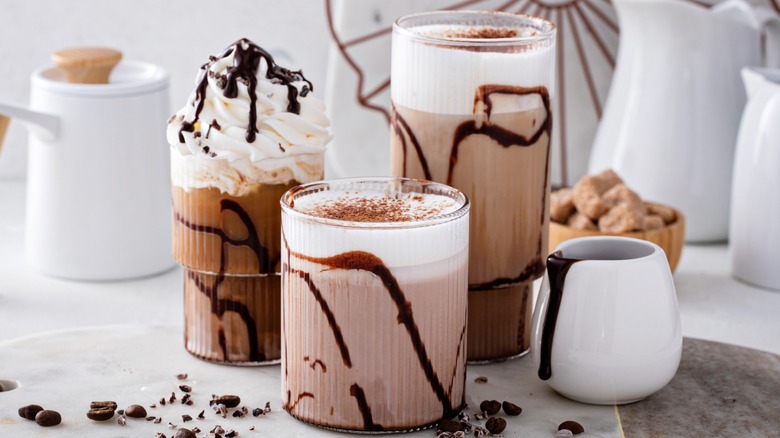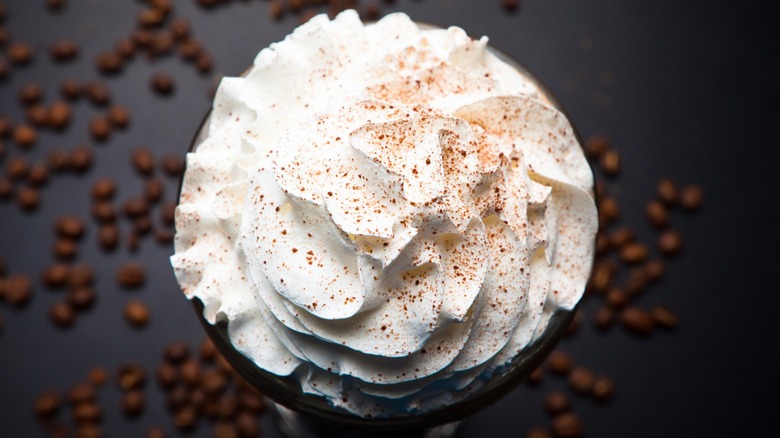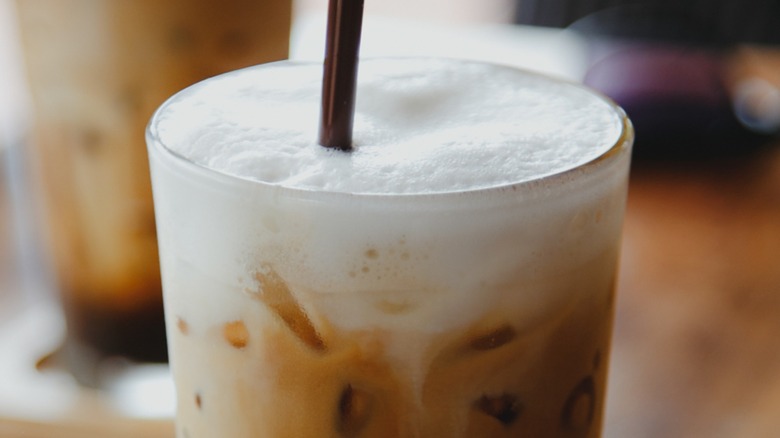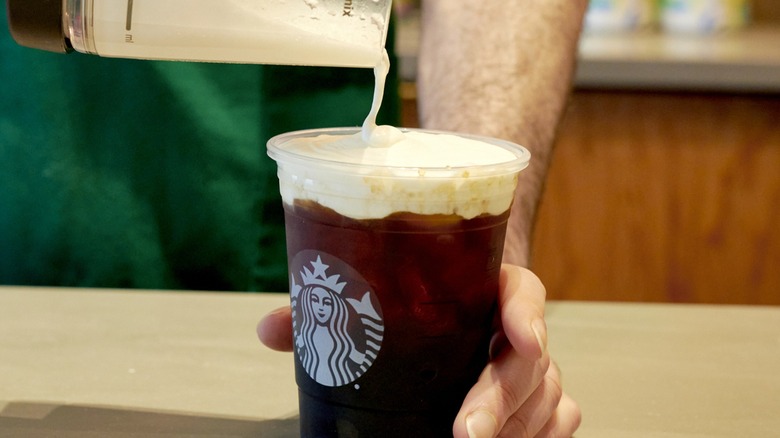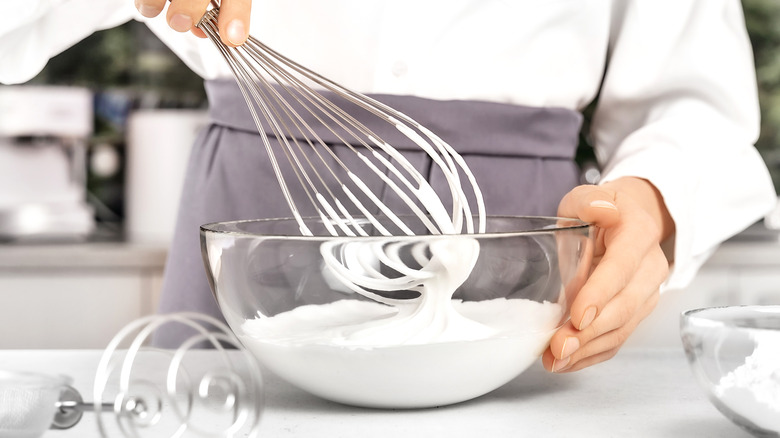Whipped Cream Vs. Cold Foam: What's The Difference?
Smooth, pillowy, and delicious, both whipped cream and cold foam make up two of the most perfect garnishes any hot or cold drink can get. From extravagantly decorated Frappuccinos to expertly balanced iced cappuccinos, these two are both must-have inclusions that work well on any café order. But with both of them being made from whipped-up dairy, you might be wondering: What's the real difference between whipped cream and cold foam?
While they might seem similar, both types of frothed dairy have incredibly different properties down to the molecular composition before and after being aerated. In general, whipped cream takes much more effort to create but is overall more stable and long-lasting, while cold foam can easily be made at home using nonfat milk and minimal implements but must be consumed within a few hours. Whipped cream also has a much longer history as an all-purpose topping on all kinds of drinks and desserts; meanwhile, cold foam isn't even old enough to get a driver's license, having been first introduced to the world in 2014.
What is whipped cream?
We know it and we love it; whipped cream is a mainstay sweet, fluffy garnish that elevates drinks, pancakes, pies, and many other tasty treats. While its exact invention is impossible to pinpoint, it became very popular in Italy and France in the 16th century, though, oddly enough, the first confirmed recipe for traditional whipped cream as we know it was published in 1545 in England. Back then, whipped cream was called a strange name: "neige de lait," or, "milk snow." Thankfully, the bizarre — if aptly descriptive — name was replaced by "crème fouettée" (French for "whipped cream") in a 1629 recipe book and the rest is history.
On the scientific side of things, whipped cream is essentially what happens when you try to beat milk into butter in too cold of an environment and stop just short of it reaching the right consistency. While this might sound fairly simple, its ingredients have evolved quite a bit over the centuries. The earliest recipes involved cream and sugar as well as egg whites, possibly to help stiffen the whipped mixture using the meringue-making capabilities of the egg whites. Luckily, electric mixers and the invention of aerated containers in the 1930s have made robust and stable whipped cream without stiffening additives easily accessible to the average consumer.
What is cold foam?
In comparison to whipped cream's centuries-long pedigree, cold foam is an entirely new innovation of the 21st century. While it's been available as a topping at some overseas franchises like Gong Cha since 2014, Starbucks was the first to introduce cold foam to the mainstream by popularizing it throughout the U.S. Its very first Starbucks debut was in December 2014, when it was served at the newly opened Reserve Roastery in Seattle. At the time, it wasn't presented as the plain and customizable topping as it's now known, but as the coffee-flavored garnish of a specialty drink called the Americano Con Crema.
Starbucks officially unveiled the new foam topping on its website in 2018, announcing that it would be available as an add-on to any drink as well as included in a handful of new drinks: the Cold Foam Cascara Cold Brew, Cold Foam Cascara Nitro Cold Brew, and Cold Foam Starbucks Blonde Iced Cappuccino. Since then, it's become a mainstay addition to Starbucks' cold brew coffee as well as other iced drinks. What's more, because it's always made fresh on the spot, Starbucks' cold foam can be customized with any number of syrup flavors or additions.
Cold foam is made with nonfat milk for best results
When you break it down, cold foam is just steamed milk reinvented and optimized for cold drinks. Conventional steamed milk is simultaneously aerated and heated using a steamer, while cold foam is made by vigorously scrambling cold milk and sweet syrup in an electric blender or mixer. While the act of mixing causes milk proteins to denature and trap bubbles, syrup adds additional viscosity and elasticity to the milk, helping it sustain a foamed-up texture without heat, which more efficiently relaxes and stabilizes fats and proteins around air bubbles.
However, this lack of heat also means that cold foam must be made with nonmilk for best results due to its higher protein content. As you might know from the way oil and grease behave in cold temperatures, fats are prone to rupturing instead of spreading when not warmed up. Even with the syrup to help, excess cold fat fails to expand around the forming bubbles and also interferes with protein bubble formation, which reduces the foam's stability. Subsequently, the less fat a milk has, the better suited it will be for making cold foam. As a bonus, this also means that cold foam has fewer calories than whipped cream — though it's also slightly less flavorful and creamy.
Whipped cream melts faster
Whipped cream is made from heavy cream with at least 22% butterfat content, preferably higher. Knowing that fats have trouble expanding around air bubbles when cold, it might sound strange that whipped cream must be made in cold temperatures. The contradiction comes from the fact that whipped cream actually relies on an abundance of fat in order to maintain volume. The longer process of more intense whipping actually starts to break the membranes of the fat molecules, making them move more freely and bind to one another. Because fat maintains a more solid structure in the cold, this allows it to easily trap air bubbles and expand into a fluffy mixture.
A structure reliant on fat isn't without its issues, though. You might see whipped cream either fail to fluff up or completely deflate after whipping due to the fats melting and releasing their trapped air. Whipped cream also disintegrates within minutes on top of a hot drink as the fats within it warm up, in comparison to the more stable cold foam that can hold itself up against higher temperatures for much longer. On the flip side, however, there's no possible way to make the flimsier bubbles in cold foam last for longer than a handful of hours. Whipped cream's stronger structure means that, when properly stored at cool temperatures, it can last for up to a day — or multiple days if stabilized with other ingredients.
